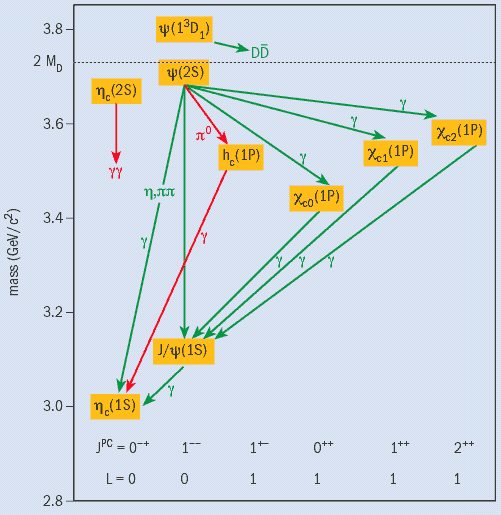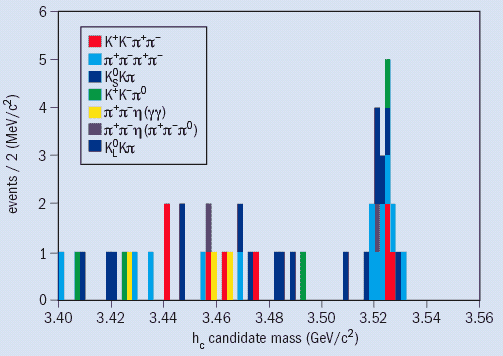The charmonium spectrum provides fertile ground for investigating the force that binds quarks together, and the CLEO detector is revealing some previously missing states, as David Cassel and Jonathan Rosner report.
It is slightly more than 30 years since the discovery of the J/ψ, the first bound state of a charmed quark, c, and its antiquark cbar, near a mass of 3.1 GeV/c2. This discovery ushered in the era of heavy-flavour physics, which now includes studies of the tau lepton and its neutrino, and the b and t quarks. As the mass of the charmed quark is quite large, the velocities of the c and cbar in a bound state are small enough that many important features of these states can be described using non-relativistic potential models. Also, at typical separations of the quark and antiquark, the shape of the ccbar potential is somewhat like that of the Coulomb potential. Hence, many features of ccbar states – collectively called charmonium – are familiar from the physics of the hydrogen atom, or more precisely, from the spectroscopy and dynamics of positronium, a bound state of an electron and a positron.
After its discovery, the J/ψ was soon identified as a 3S1 ccbar bound state, that is, a spin-triplet (S = 1) S-wave (L = 0) level with total spin J = 1. Several other ccbar levels were observed soon after, including the ψ(2S), or ψ’, an excited version of the J/ψ; several orbitally excited triplet P-wave (3PJ = 0, 1, 2) levels χcJ; a D-wave level at 3.77 GeV/c2; and a spin-singlet 1S0 level known as the ηc(1S). Figure 1 illustrates the low-mass charmonium spectrum and the principal transitions between charmonium states expected from the analogy of ccbar states with positronium states. Among the low-mass states expected, only the ηc(2S), an excited version of the ηc(1S), and the hc, a spin-singlet P-wave 1P1 level, steadfastly refused to make significant appearances, despite reported sightings that were not confirmed.

A few years ago, with the conclusion of its 20-year programme of studies of the decays and spectroscopy of the bottom quark, the CLEO Collaboration at the Cornell Laboratory for Elementary-Particle Physics turned its attention to the study of charm and charmonium. The National Science Foundation supported converting the Cornell Electron Storage Ring (CESR) to CESR-c, including installing wiggler magnets to enhance luminosity in the charm threshold region (see CERN Courier May 2003 p7). The new programme benefits enormously from the versatility of the CLEO detector, upgraded to CLEO-c (figure 2), which is unrivalled by other detectors that have operated in this energy region. This latest version of the CLEO detector features excellent charged-particle tracking, neutral-shower energy resolution, and particle identification.

The ease of studying the lower-mass charmonium states is due in part to their narrow decay widths (long lifetimes), which are much smaller than the mass differences among the states. Above the charm threshold, where production of a pair of charmed mesons, D, becomes possible – that is, above 2MD ≈ 3.73 GeV/c2 – charmonium states are much broader and they may overlap, so the spectroscopy becomes more complicated.
The charmonium spectrum provides fundamental information about the nature of the strong force holding quarks together. If current ideas about the nature of the interquark force are correct, the mass of the hc, M(hc), is expected to be near the spin-weighted average of the masses of the χcJ levels, 〈M(3PJ)〉 ≈ 3525 MeV/c2. This prediction for M(hc) is based on the expectation that the dominant spin-dependent interquark force is Coulomb-like, as predicted by quantum chromodynamics (QCD), the theory of the strong force. It is borne out by calculations in lattice gauge theory, which predict a difference of at most a few mega-electron-volts/c2 between the masses of the spin-singlet and spin-triplet P-wave states.
Charm and charmonium data taken at CLEO so far include a sample of slightly more than 3 million ψ(2S) decays, as well as continuum data below the ψ(2S), charm data just above DDbar threshold, and data at higher energies for a nascent programme of Ds investigations. The ψ(2S) data were used to search for the isospin-violating transition ψ(2S) → π0hc. A similar transition in the bbbar system (from the Υ(3S) level) was proposed some time ago as a way to search for the 1P1 state hb (Voloshin 1986). The transition was expected to occur with a branching fraction of only about 10-3, and so substantial suppression of background was required. The hc was expected to decay to the ηc and a photon of energy around 500 MeV with a branching fraction of roughly 40%, so this photon was sought in coincidence with the slow π0 (energy around 160 MeV) from the first transition.
The search for the hc using just the 160 MeV π0 and 500 MeV photon at CLEO produced good results (Rosner et al. 2005 and Rubin et al. 2005). Analyses of this inclusive signature yielded M(hc) = 3524.9±0.7±0.4 MeV/c2 and a product of branching fractions Bψ’Bh ≡ B(ψ(2S) → π0hc)B(hc → γηc) = (3.5±1.0±0.7) × 10-4, both in good agreement with expectations.

The inclusive hc signal sits on a considerable background. Further reduction of this background is possible if one reconstructs the decay of ηc into specific final states. The hc peak stands out quite distinctly under such circumstances (figure 3). This exclusive analysis yielded values of the hc mass and product branching fraction consistent with those of the inclusive measurement, but with slightly larger errors. However, as a result of the low background, the statistical significance of the exclusive measurement is higher than that of the inclusive measurement, providing a more conclusive observation of the existence of the hc. The combined inclusive and exclusive analyses yield M(hc) = 3524.4±0.6±0.4 MeV/c2 and Bψ’Bh (4.0±0.8±0.7) × 10-4, very close to theoretical expectations.
The hc thus lies at 1.0±0.6±0.4 MeV/c2 below the average 3PJ mass, supporting the QCD prediction and indicating little contribution from a long-range spin-dependent quark-confining force or coupled-channel effects, which could cause a displacement from this value. It is barely consistent with an interesting (but non-relativistic) bound that predicted the hc should lie no lower than 〈M(3PJ)〉 (Stubbe and Martin 1991).
An independent experiment at Fermilab, E835, has produced additional evidence that the hc is nearly degenerate with 〈M(3PJ)〉 (Andreotti et al. 2005). By forming hc candidates using collisions of antiprotons in the Accumulator Ring with protons in a gas-jet target, the E835 Collaboration found 13 candidates for the process pbarp →hc → γgηc → γ(γγ). Utilizing the carefully controlled energy of the antiproton, the team found M(hc) = 3525.8±0.2 0.2 MeV/c2 and a decay width Γ <1 MeV.
The CLEO Collaboration plans to collect more ψ(2S) data, enabling a better measurement of the hc mass and production rate. It is hoped that the predictions of lattice gauge theories will keep pace with these improvements.
Further discoveries
The hc is not the only new charmonium state below charmed threshold to which CLEO has contributed substantially. Several years ago, the Belle Collaboration observed a candidate for ηc(2S) in B→ K(KSKπ) (Choi et al. 2002) and e+e– → J/ψ + X (Abe et al. 2002), the mass of which was incompatible with that of the previously claimed observation. By studying its production in photon-photon collisions, the CLEO collaboration has confirmed the presence of this state (Asner et al. 2004), as has the BaBar Collaboration. The mass of the ηc(2S) is found to be only 48±5 MeV/c2 below the corresponding spin-triplet ψ(2S) state, a hyperfine splitting that is considerably less than the difference of 117 MeV/c2 seen in the 1S charmonium states, that is, between the J/ψ and the ηc(1S). This difference may well be due to the proximity of the charmed meson-pair threshold, which can lower the mass of the ψ(2S) by tens of MeV/c2.
Researchers at the CLEO Collaboration found that the product Γ(ηc(2S) → γγ)B(ηc(2S) → KSKπ) is only 0.18±0.05±0.02 times the corresponding product for ηc(1S). This could pose a problem for descriptions of charmonium if the branching ratios to KSKπ are equal. More likely, the heavier ηc(2S) has more decay modes available to it, so its branching ratio to KSKπ is likely to be less than that of the hc(1S).
Altogether it is remarkable that more than 30 years after the first discovery, charmonium continues to yield new information and new challenges to elementary-particle physics, thanks to improvements in collider luminosities and detector capabilities. Recent advancements include surprises from charmonium spectroscopy above charm threshold to which CLEO is also contributing.
With the recent discoveries of the hc and the ηc(2S), all of the expected bound states below charm threshold have now been observed. With the exception of the mass of the ηc(2S), the observed masses and branching fractions are in quantitative agreement with theoretical expectations, while the lower-than-expected ψ(2S) – ηc(2S) mass splitting stresses the importance of the nearby DDbar- threshold. The quantitative agreement between theory and experiment for the states below charm threshold provide a firm foundation for developing an understanding of the new states found above the threshold.
Further reading
K Abe et al. (Belle Collaboration) 2002 Phys. Rev. Lett. 89 142001.
M Andreotti et al. (Fermilab E835 Collaboration) 2005 Phys. Rev. D 72 032001.
D M Asner et al. (CLEO Collaboration) 2004 Phys. Rev. Lett. 92 142001.
S K Choi et al. (Belle Collaboration) 2002 Phys. Rev. Lett. 89 102001.
J L Rosner et al. (CLEO Collaboration) 2005 Phys. Rev. Lett. 95 102003.
P Rubin et al. (CLEO Collaboration) 2005 Phys. Rev. D 72 092004.
J Stubbe and A Martin 1991 Phys. Lett. B 271 208.
M B Voloshin 1986 Yad. Fiz. 43 1571 (Sov. J. Nucl. Phys. 43 1011).








